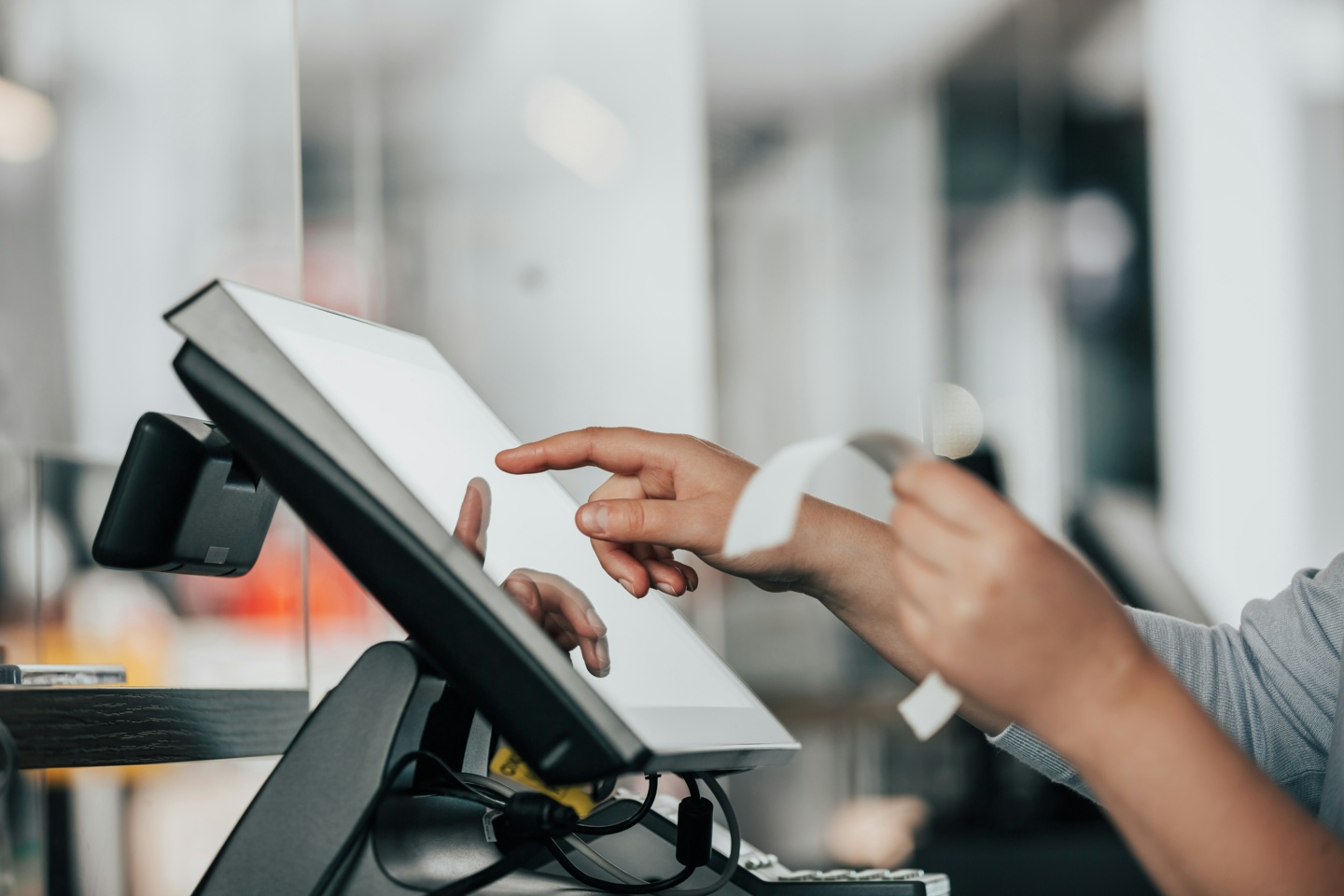There’s a lot to know about modern point-of-sale systems, whether you run a cafe, a bar, or a hotel restaurant. But how much does it actually cost to get a top-notch POS system in 2024? That's the question that we're here to explore.
In this article, we'll break down all the costs you need to consider—hardware, software, installation, and ongoing support—so you can make a smart decision for your F&B business.
What is a restaurant POS system?
To put it simply, a POS (or Point-of-Sale) system is a combination of software and hardware that helps restaurants accept payments and track sales. It’s an important part of a digital guest map.
POS systems can do many things: process orders, split bills, report on sales, manage employee schedules, inventory, and more. In many cases, this is an all-encompassing solution that lies at the center of your business.
Whenever a server or guest places an order at the restaurant, the POS system records every detail of the transaction and updates the inventory accordingly. Legacy POS systems often require on-site computer servers and have been associated with high costs and maintenance complexities.
However, cloud-based POS solutions have changed the game, offering cost-effectiveness and unparalleled flexibility. Such modern systems allow to make real-time updates to menus and provide invaluable sales analytics to optimize restaurant operations.
What determines the cost of your restaurant's POS system?
When researching the costs of this restaurant technology, you need to consider all the factors that can impact pricing. The primary costs include hardware and software, and your choice of payment processor can also significantly affect the overall expense.
Taking the time to evaluate all the aspects will help you choose a POS system that meets your current requirements and supports your restaurant's growth in the long term.
Hardware costs
The POS hardware you need can vary based on what your business requires. All these components work together to keep your point-of-sale system running. Here is a short list of typical hardware components and their estimated costs based on data from Amazon:

- ● Terminals: $200 - $1,200 per terminal.
- ● Cash drawers: $100 - $300.
- ● Receipt printers: $150 - $400 per printer.
- ● Tablets: $200 - $800 per tablet.
- ● Handheld devices for order taking and payment processing: $300 - $700 each.
- ● Barcode scanners: $20 - $300 per scanner.
- ● Kitchen display systems (KDS): $500 - $1,500 per display.
Software costs
The software costs vary depending on the type of POS system you choose. It can start from nothing for basic versions with limited features and go up to $100-$300 per month for cloud-based systems. Some providers require a one-time purchase fee, while others have a monthly subscription model.
- ● A one-time purchase is a single, upfront payment for a perpetual license. The price typically ranges from $500 to $2,000.
- ● The subscription-based model involves ongoing monthly or annual payments. Monthly fees typically range from $50 to $300 per terminal.
Installation fees
Installing your restaurant POS is another factor that influences price. This includes setting it up and customizing it. Some providers include these services in the overall price, while others charge extra. Consider these costs carefully, as a smooth installation process can save time and hassle in the long run.
- ● Professional installation that ensures all components are correctly set up and configured may already be included in the cost of your hardware, but in general, the fees vary from $500 to $2,000.
- ● DIY setup is typically cheaper, but requires technical know-how. Here, the price can be somewhere between $0 to $500 and you will mainly spend it on self-purchased tools and minor accessories.
Training and support
Effective training and ongoing support are essential for the smooth operation of your system. It equips your staff with the skills they need to use the system efficiently, and reliable support services will help you address any technical issues that arise.
- ● Initial training usually takes the form of a one-time fee for staff training sessions. Price range: $200 - $1,000.
- ● Ongoing premium support requires monthly or annual fees for continued technical support and costs around $20 - $100 per month.
Payment processing fees
Payment transaction fees are charged by the payment gateway for each transaction, either as a percentage, fixed fee, or both. Some providers have variable fees, while others offer fixed rates. We recommend fixed rates for predictability and ease of planning. Transaction fees usually range from 1.5% to 3.5% per transaction.
Various integrations
Integrating your POS system with other software solutions can enhance its functionality, but it may come with extra costs of around $20 - $100 per month. However, the integration with CRM, marketing, accounting software, and other add-ons offers benefits like improved efficiency and synchronized data.
What are the pricing models for restaurant POS systems?
The three main pricing models are a one-time purchase, subscription-based pricing, and pay-as-you-go model. Each of them has its advantages and disadvantages, catering to varying needs and budgets.

One-time purchase
Under this model, businesses pay a single upfront fee for the POS software license. This approach offers predictable costs without recurring fees and allows full ownership of the software.
The main drawback is that it comes with a high initial cost and may not include updates or new features, increasing the risk that the software could become outdated.
Examples of costs include basic licenses ranging from $500 to $2,000 and advanced versions for large businesses from $2,000 to $5,000.
Subscription-based pricing
This type of pricing involves paying monthly or annual fees for POS software. This model requires lower initial investment, includes regular updates, and is easy to scale as the business grows.
Nevertheless, ongoing payments can add up over time, potentially making it more expensive in the long run.
Basic monthly subscriptions range from $50 to $150 per terminal, while advanced versions range from $150 to $300 per terminal. Annual subscriptions often offer a discount of 10-15% off the monthly rate.
Pay-as-you-go
The pay-as-you-go model charges fees based on usage, such as the number of transactions or specific features used. It offers flexibility and lower initial costs, making it ideal for seasonal businesses or those with fluctuating sales.
Still, variable costs can make budgeting difficult, and high transaction volumes can lead to substantial fees.
This model benefits seasonal businesses, which pay more during busy times and less during slow periods, and small or new businesses that can keep initial costs low and scale expenses as they grow.
Do you own a seasonal lodging and want to maximize revenue throughout the year? Take a look at our 10 best strategies to sell hotel rooms during high and low seasons.
Uncovering all the hidden costs
Hidden costs can significantly impact the total cost of ownership and should be factored into your decision-making process. Here are some less obvious expenses to consider.

Maintenance costs
Even after the initial purchase and setup, ongoing maintenance is necessary to ensure the POS system operates smoothly. Regular servicing and maintenance are required to keep the hardware and software in optimal condition, which can include updates and minor repairs.
Upgrade сosts
Keeping your POS system up to date is essential for taking advantage of new features and maintaining security. Some providers offer free software updates, but major upgrades or new versions might incur additional fees.
As technology advances, upgrading hardware components may be necessary to ensure compatibility and efficiency, with an estimated cost of $500 - $2,000 every few years.
Potential downtime
Downtime can occur due to system failures, updates, or maintenance, leading to lost sales and operational disruptions.
Regular maintenance might require the system to be offline for short periods, and while this is usually planned to minimize disruption, it can still affect operations, with the estimated cost varying based on business size and maintenance duration.
Budgeting tips for choosing a POS System in 2024
We’ve compiled some practical budgeting tips to help you make a wise investment in 2024. Below you’ll find 5 ways to make sure you get the best value without compromising on essential features.
Tip №1 |
Opt for cloud-based systems |
Choosing a cloud-based POS offers many benefits. These systems typically have lower initial costs because they don't require a lot of hardware investments. They are also scalable and allow you to adjust resources as your business grows. |
Tip №2 |
Negotiate with vendors |
You can definitely ask for discounts on long-term contracts, bulk purchases, or referrals. Also, take advantage of free trials and demos to test the system before committing. It's wise to compare quotes from different vendors to find the most cost-effective solution that meets your needs. |
Tip №3 |
Leverage existing equipment |
To save on hardware costs, consider using your current tablets or computers as POS terminals if they're compatible with the chosen POS software. Begin with essential components of the POS system and gradually add more features or terminals as your budget allows and your business expands. |
Tip №4 |
Focus on online training |
Take advantage of online training resources and tutorials provided by the POS provider. These resources offer a cost-effective way to train your staff, as they eliminate the need for in-person training sessions. |
Tip №5 |
Monitor and optimize usage |
Proactive optimization of your POS system is vital for enhancing business performance. Use your POS system's reporting features to analyze sales, inventory, and customer trends, identifying areas for improvement and cost reduction. Regular audits can help you to avoid paying for unused features. |
Top POS system providers and their pricing
In today's market, popular POS system providers offer a variety of features and pricing structures tailored to different types of restaurants. Here are the prices for the leading POS system providers in 2024, according to Forbes Advisor.
Square POS
Square is known for its user-friendly interface and affordability, making it a popular choice for small to medium-sized restaurants. It offers a range of features, including payment processing, inventory management, and online ordering.
Pricing
Hardware costs |
Register: Prices start at $149 for an iPad stand (iPad not included) and go up to $799 for the Square Register Mobile Reader: Costs range from free to $49 per reader |
Software costs (Monthly subscription) |
Square Plus: Ranges from $29 to $69 per month, including advanced features for retail, restaurant management, appointments, and staff management |
Payment processing fees |
Fees range from 2.5% + $0.10 to 3.5% + $0.15, varying based on the subscription plan and type of sale |
Toast
Toast is a comprehensive POS system designed specifically for the restaurant industry. It offers robust features such as detailed reporting, kitchen display systems, and integrated online ordering.
Pricing
Hardware costs |
Register: Prices are quoted based on the plan, with an estimated cost of $1,350 for a countertop register bundle Mobile Reader: The starter kit is free with a terminal included, with additional units estimated at $450 each |
Software costs (Monthly subscription) |
Ranges from free to $165 per month, with optional add-ons. The highest tier includes support for online ordering and a take-out app
|
Payment processing fees |
Interchange rates vary depending on the card brand and type of sale |
Clover POS
Clover offers a flexible POS system that can be customized with various apps to suit different restaurant types. It provides features like employee management, customer loyalty programs, and robust reporting.
Pricing
.
Hardware costs |
Register: Prices start at $1,349 for counter registers and go up to $3,647 for complete restaurant systems, with the option to connect a supported card terminal. Mobile Reader: $49 per reader and $499 per mobile terminal. |
Software costs (Monthly subscription) |
Ranges from $14.95 to $94.85 per month for POS features tailored to businesses such as restaurants, services, retailers, and mobile sellers. |
Payment processing fees |
Fees range from 2.3% + $0.10 to 3.5% + $0.10, depending on the plan and type of sale, or the option to use a supported third-party payment provider. |
Lightspeed
Lightspeed is ideal for both small and large restaurants, offering advanced features like inventory management, analytics, and multi-location support. It is known for its strong customer support and customizable interface.
Pricing
Hardware costs |
Register: Prices are quoted upon sign-up or you can connect a supported card terminal. Mobile Reader: Prices are also quoted upon sign-up. |
Software costs (Monthly subscription) |
Ranges from $39 to $289 per month when paid annually, depending on the plan, plus $39 per additional register per month. Higher tiers include additional features such as e-commerce, loyalty programs, specialty functions, accounting, and advanced reporting. |
Payment processing fees |
Fees range from 2.6% + $0.10 to 3.5% + $0.10 depending on the type of card and sale, or you can use a supported third-party payment provider. |
HotelFriend POS
HotelFriend POS offers a streamlined and convenient solution for managing your restaurant's sales. Whether taking orders via tablet or self-service kiosk, HotelFriend's POS system integrates all orders into a single, cloud-based platform, ensuring efficient operation throughout your business.
Hardware costs |
Terminals are priced between $86 and $1,200. |
Software costs (Monthly subscription) |
Integrated with HotelFriend PMS, the POS software costs range from $13.58 to $16.30 per room per month.
|
Payment processing fees |
Fees range from 0.20% + $0.13 to 4.15% + $0.13, depending on the type of card and sale. |
Conclusion
Selecting the right POS system for your restaurant is crucial for its productivity and success. Beyond simply processing orders and payments, top-notch POS systems integrate all aspects of daily operations into one efficient platform.
Remember, that when you invest in the right POS system, you invest in making your restaurant more efficient and ready for growth in 2024 and beyond. Use the insights from this article to choose the system that will help your business reach new levels.
